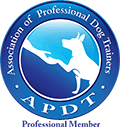Archive OLDT :: The Art of Training
Training is an exercise in building relationship rather than obedience. We should expect the same polite, respectful behavior from our canine family members as we do from our human ones. Enlist the help of children during training so that your dog learns to respect little humans as much as she does big ones.
Choosing the Technique
The art of training is knowing which technique to employ when. For simple behaviors such as “sit” or “down”, lure-based training is usually the most straight-forward approach. In this case, a treat is used to lure the dog into the desired position and,
with repetition, she learns to perform the behavior simply upon seeing the hand signal. So, for instance, when training “sit”, lure the position by holding a treat in your up-turned palm above your dog’s nose and lead her nose up and back, thus causing her to lower her butt. Mark the moment her butt hits the ground with a reward marker. When she’s doing this with fluency, fake the lure in the hand, giving the same signal with your up-turned palm, and treat from your other hand. Violá! You have “sit” on cue!
For behaviors that occur spontaneously, using a technique called capturing is often the most effective approach. For instance, teaching your dog to sneeze on cue can be a very cute trick. To do this, mark the moment that your dog sneezes with a reward marker and give her a treat. By reinforcing the behavior in this way, you are increasing the probability that the behavior will occur again and, if you can predict when she’s about to sneeze, you can put the verbal cue ahead of it, mark it and treat. “Do you have allergies?” makes for a cute cue!
For complex behaviors, such as opening the refrigerator door, extracting a beer, and delivering it, shaping through successive approximations is the most effective method. So for “Get me a brewski!”, you might shape by: first training her to look at the refrigerator; then training her to target the refrigerator door (i.e. touch the handle with her nose); then training her to lick or put an open-mouth on the handle; etc. And then, using a technique called back-chaining, you work backwards from the end of the sequence, at each step appending the next earlier step: get your dog to drop a beer can into your hand; then have her do a basic fetch of a beer can (picking up and dropping the can in your hand); and finally precede with the refrigerator door sequence. A word of caution: By teaching your dog to open your refrigerator door, you are giving her the keys to the kingdom, a kingdom that will never be safe again!
Timing
The secret to training is timing, and the placement of the reward marker, whether it’s a happy “yes!” or the click of a clicker, must be accurate in order for your dog to learn a behavior quickly.
Particularly when training by capturing or shaping, a tool called the clicker, which is a little device that produces a distinctive clicking sound when pressed, can be
helpful. To use the clicker, first you must “charge it up,” which means that you need to establish with your dog that the sound of the click is reinforcing or rewarding. To do this, randomly click and then produce a treat. Do this over and over until, when she hears the click, your dog’s head turns in happy anticipation. Then you know an association has been established. Now, when you click your pup at the exact moment that she performs the intended behavior (i.e. when she sneezes), she knows she’s done something right and she’s ready to collect on it. Remember: The timing of the reward marker is the important thing here, not the delivery of the treat!
Training ABCs
When employing positive training, we use treats to reinforce, or reward, a target behavior. My clients often wonder how long they will have to keep giving treats; will they be tied to treats forever?! The answer is emphatically NO! Treats are an incentive for the dog to learn a challenging, new behavior. Once the behavior has been established, you reinforce intermittently, sometimes rewarding, sometimes not. Gradually, over time, the act of performing the behavior itself becomes reinforcing because of its happy history.
An example of this is training sit. To start, we use the treat to lure the position but, in no time, when the dog is effortlessly sitting on cue, we start to ask for sits throughout the day – when we’re putting the leash on before a walk, when we’re putting down a stuffed Kong, before we offer a rope toy for a game of tug. Many wonderful life rewards are earned by a sit, and so the act of sitting itself becomes imbued with positive, happy feelings.
The Soda Machine vs. Slot Machine Model
Understanding reinforcement scheduling is more tangible when illustrated with the soda machine vs. slot machine models. With a soda machine, when you pump money in, you always get a soda. On the occasion when nothing comes out, you immediately assume the soda machine is broken and you try no further – your coin-pumping behavior is extinguished! A slot machine is very different: gamblers recognize that sometimes a pull of the arm will pay and sometimes it won’t; actually, more often it doesn’t, but it pays often enough to keep the gambler hooked.
In training, we most often exercise the slot machine paradigm. When first installing a behavior, we reward each and every time to increase the occurrence of the behavior but, once the behavior is fairly fluent, we must go to an intermittent schedule to avoid extinction. We become a slot machine; sometimes we pay and sometimes we don’t. If you notice performance of the behavior falling off, you may not be paying frequently enough to keep your gamblin’ pooch playing. However, if you pay too frequently, you become too much like a soda machine; then the times you don’t pay you seem broken and performance stops completely.
Alternatively, there are a few behaviors that benefit from the soda machine paradigm – an emergency recall, for instance. In such a case, in order to ensure an unfailing level of performance, we need to pay richly and consistently.
The “Good Sit” Controversy
Some trainers espouse the use of the verbal cue when praising its performance. So, for instance, in response to a dog’s sitting upon cue, they suggest saying “Good sit!” as praise. This is not a practice I advocate. Does the dog know that “sit” is a state of being as well as an action? I believe that, when a dog hears the cue “sit”, she responds with an action that she associates with that cue. She sits. When you praise her by saying “good sit!”, your pup is now in a quandary… Since she’s in the sitting position, there is no way to perform the sitting action and so this use of the cue becomes irrelevant. The more times a cue is used in a way that is irrelevant to the dog, the less meaningful and powerful it becomes. The cue is diluted. So, instead, just say “good pupster!” or the like!
Some Final Tips
Food is not the only agent of rewarding or reinforcing a behavior. Even when your dog is full, there are other things you can use… playing with a favorite toy, going for a walk, getting pats and love and verbal praise. To a dog intent on moving things, nothing will be more rewarding than allowing her to chase a napkin being carried by the wind! Use all of these to your best advantage. Remember, though, that you need to select a reinforcer appropriate to the task: For a sedentary exercise like “stay”, rewarding with a toy would be counterproductive.
Offer reinforcement only for desired behaviors. An ill-timed pet when your dog’s jumping up will encourage jumping up.
And, finally, remember that what is reinforcing now might not be reinforcing ten minutes from now. To a hungry dog, food is reinforcing; love and petting are more likely an annoyance. When your dog’s appetite is sated, then play or a bit of lovin’ might be just right!




